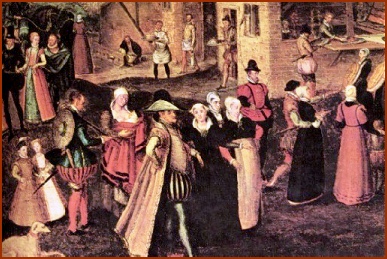|
Sumptuary laws were enacted in many centuries and
countries. In Elizabethan England, these laws attempted to
restrict the sumptuousness of dress in order to curb
extravagance, protect fortunes, and make clear the necessary and
appropriate distinctions between levels of society.
The principal concern was that money spent on frivolous display
would be better spent on the state of more important things, such
as horses, critical to a society always in peril of the
neighbors.
The other concern was that letting anyone wear just anything must
lead inexorably to moral decline. If you couldn't tell
a milkmaid from a countess at a glance, the very fabric of
society might unravel.
Enforcement
These statues were almost impossible to enforce and were
essentially a lost cause. There were no "costume
police". It is most unlikely that any yeoman's
ambitious son in a new sugarloaf hat ever found himself stopped
on the street by a constable zealously performing his duty, and
be carted off to the magistrate.
If your neighbor complained, there might be some action, a
warning and possibly a fine. The fine, however, was a
penalty, not a license fee. You could not buy a license to
wear something above your station. And you could always turn the
tables on your neighbor another time.
According to some sources, young gallants entering London could
be stopped to have their swords measured and, if too long,
broken.
If you appeared at Court in a ridiculous ruff, it's unlikely
you would be sent to the Tower. But if the Queen decided to
point and laugh, you could kiss your career goodbye.
Some things are self-correcting.
About the citations
Acts of the Privy Council and other legal documents throughout
English history are cited both with the calendar date "in
the year of our lord" (Anno Domini) and the regnal year, or
as you might say, "in the year of our monarch".
For example. The first Statute here is dated:
15 June 1574, 16 Elizabeth I
That is, June 1574, the 16th year of the
reign of Elizabeth I. The Queen's Accession Day is in
November, hence the years of her reign are counted from
November.
In period, this would have been cited simply as 16 Elizabeth,
since monarchs of a name are not numbered until there is more
than one. (Hence, King John is never referred to as John
the First.)
About the edition
Elizabethan lawmakers, much like modern ones, had no notion of
paragraphing. I have provided paragraph breaks and
attempted to simplify some diction in the interest of
clarity. For the most part, however, only spelling and
punctuation have been modernized.
-- Maggie Secara
- Who Wears What I: Enforcing Statutes of Apparel, issued at Greenwich, 15 June 1574, 16 Elizabeth I
- Who Wears What II: Enforcing Statutes of Apparel, issued at Westminster, 6 May 1562, 4 Elizabeth I
- Concerning Ruffs, Hose, and Swords: Issued at Westminster, 6 May 1562, 4 Elizabeth I
- Fines: Noting Certain Statutes to be Enforced, issued by the Privy Council, Westminster, 7 May 1562, 4 Elizabeth I
- Concerning Horses: Enforcing Statutes of Apparel, issued Westminster, 7 May 1562, 4 Elizabeth I
|

